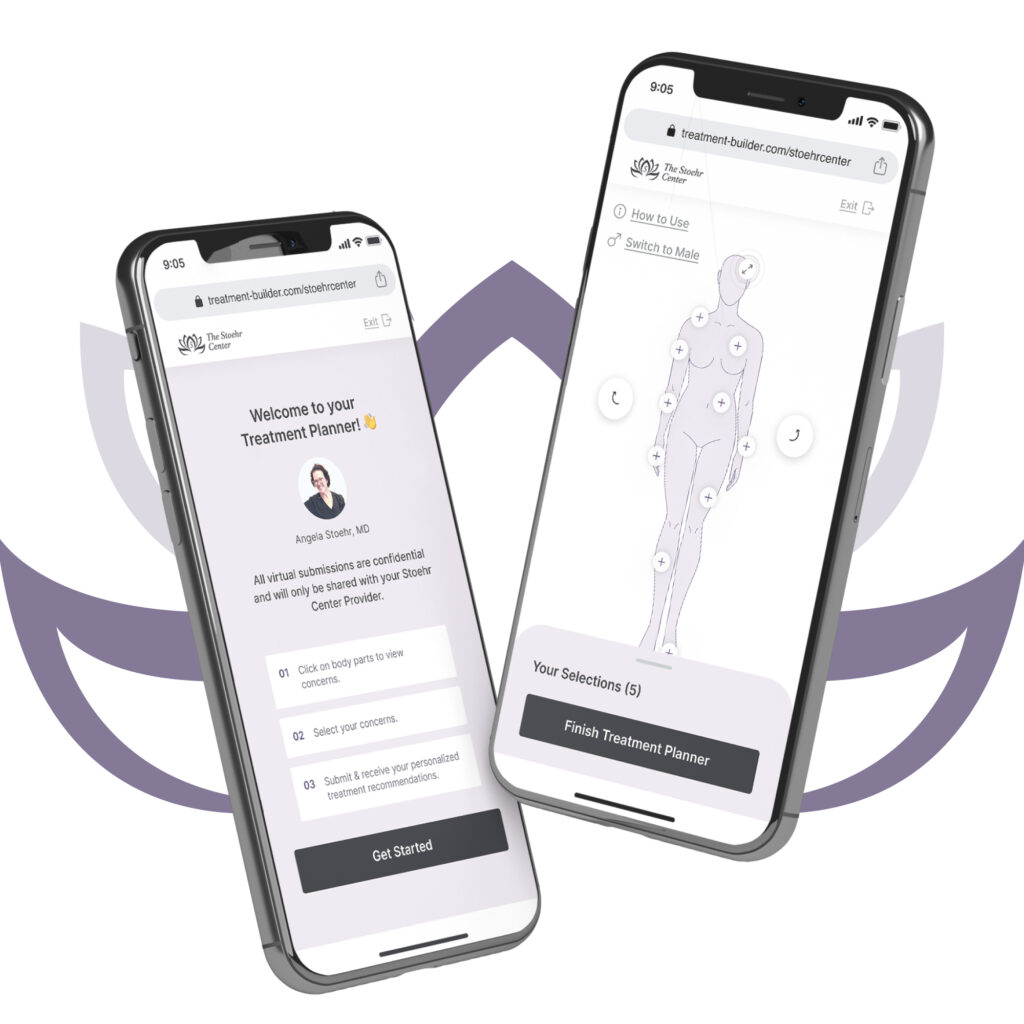
Long story short, most people, including physicians, don’t fully understand pelvic pain. There are widespread misunderstandings regarding both causes and treatments. As a result, many people suffer for years without reprieve—we’re here to change that.
At The Stoehr Center, we specialize in education, diagnoses, and treatment for pelvic discomfort near Plano. Over the years, we’ve seen how this condition can debilitate and isolate its victims. If you take one thing away from us, let it be that hope exists for those with pelvic pain.
Our comprehensive approach to addressing pelvic pain includes support for chronic conditions, gynecology, mental health, and more. We’re focused on achieving sustainable relief and enhanced well-being for all our patients experiencing pelvic discomfort.
Understanding Pelvic Discomfort
A staggering 26% of people with vaginas experience chronic pelvic pain!
Pelvic pain can interfere with daily activities, intimate relationships, and general health. You might experience mild discomfort, which can worsen into persistent aching, sharp pain, or a heavy feeling in your lower abdomen. Many things can cause these symptoms, including underlying health problems, so it’s crucial you visit a medical professional.
At The Stoehr Center, we specialize in identifying the root cause of your pain and providing effective, personalized care.
What does pelvic discomfort feel like?
Pelvic discomfort varies widely. Some people simply experience pressure, while others feel intense, take-your-breath-away pain as if they have inflamed pelvic muscles. No matter where you land, paying attention to what’s going on “down there” can help you have a more productive conversation with your doctor.
Common descriptions of pelvic discomfort include:
- Pressure or tightness
- Soreness
- Sharp pain
- Burning
- Cramping
Pelvic discomfort near Plano also varies depending on when it occurs, with some individuals feeling these sensations intermittently and others experiencing constant discomfort.
Certain behaviors can bring on or worsen these symptoms:
- Sitting
- Prolonged standing
- Waste elimination
- Heavy lifting
- Exercise
- Sexual activity
- Coughing or sneezing
- Stress
Frequently, related symptoms accompany pelvic discomfort:
- Bloating
- Urinary or bowel issues
- Frequent urination
- Painful urination
- Incomplete emptying
- Lower back pain
- Pain during sex
- Radiating pain
Chronic pain frequently leads to difficulties with mobility, sleep, and energy levels. Rather than just toughing it out, prioritize your quality of life by voicing your pain.
When should you see a doctor?
Sudden or severe pelvic discomfort can be an emergency. If you have new or worsening pain, see a doctor right away.
Pelvic pain isn’t always a cause for worry. Digestive trouble, menstrual cramps, and exercise-induced soreness can cause mild discomfort that doesn’t require immediate attention. However, you should always seek attention for anything that persists or exceeds mild discomfort—seriously 🫵
Patients suffering from chronic pain often discount their own experience. And after hearing the same unhelpful clichés from friends, family, and even physicians, it’s no wonder this is the case. Phrases like, “Are you sure it’s not in your head?” “Maybe you’re just stressed out,” or “Pain is just part of being a woman,” minimize the reality of your situation.

That’s why we passionately encourage everyone suffering from pelvic discomfort to advocate for themselves. Listen to your body, and know that solutions exist at The Stoehr Center.
Common Cause of Pelvic Discomfort
Many conditions can cause pelvic discomfort near Plano, but here are the most frequent diagnoses.
Endometriosis
In endometriosis, uterine tissue grows outside the uterus, often attaching to organs such as the bladder or ovaries. This can lead to pain during your period, sexual intercourse, or unexpectedly, and may also include bladder and bowel difficulties.
Vulvodynia/Vestibulodynia
Vulvodynia involves burning or throbbing pain in the external genitalia, often triggered by touch or intercourse, with no infection or visible ulcers. Vestibulodynia, a type of vulvodynia, produces burning or stinging pain in the vaginal opening, triggered by contact or sexual activity.
Vaginismus
Involuntary vaginal muscle spasms characterize vaginismus, leading to painful intercourse and medical examinations.
Bladder Pain Syndrome
Bladder pain syndrome (BPS), also called interstitial cystitis, causes persistent bladder pain or discomfort for more than 6 weeks, even without an infection. Those with BPS often feel they need to urinate all the time (over 14 times a day, and 5 to 6 times at night) and experience pain with bladder filling.
Irritable Bowel Syndrome
Irritable bowel syndrome (IBS) involves gas, bloating, abdominal pain, and changes in stool consistency (diarrhea or constipation) and color.
Pelvic Floor Dysfunction
Pelvic floor dysfunction occurs when your pelvic muscles and ligaments are not working properly. This condition often results from weak muscles, reducing urinary and bowel control. Occasionally, muscle knots develop in the pelvic area that’re acutely painful, especially with intercourse.
Adenomyosis
Adenomyosis occurs when uterine tissue grows into the uterine wall, causing pelvic pain, heavy periods, painful sex, and an enlarged uterus.
Fibroids
Fibroids are noncancerous tumors that grow in or on the uterus. They can cause heavy menstrual bleeding, pelvic pain, pressure, frequent urination, and pain during intercourse.
What to Expect at a Pelvic Discomfort Appointment
At The Stoehr Center, your visit will start with a general consultation, followed by relevant testing and treatment.

Consultation
It takes vulnerability to talk about pain, especially when it’s in a sensitive area like your pelvis. But here’s the deal: we talk about pelvic discomfort near Plano all day, every day. So don’t be embarrassed to be honest with us—we’ve seen it all!
Diagnostic Tests
Once we have a comprehensive understanding of your medical history and ongoing symptoms, we’ll move on to relevant diagnostic testing. Depending on what arises during your consultation, we may perform a physical examination, ultrasound, MRI, or labs. These tests help us rule out any infections, hormonal problems, or structural abnormalities.
Personalized Plan
Once we’ve fully explored your symptoms and diagnostic testing, we’ll move forward with treatment. There are a wide variety of treatments we may pursue based on your condition. Unlike some doctors who take a one-size-fits-all approach to pelvic pain (spoiler: that size rarely fits), we tailor our treatment plans to your unique needs.
Treatment Options for Pelvic Discomfort
As a leading provider for pelvic discomfort, we perform several advanced procedures to help you find relief from your symptoms.
SoLa Pelvic Therapy
SoLa pelvic floor therapy involves the use of a gentle laser to relieve a range of pelvic pain conditions. Using a small wand that gently carefully in and out of the vaginal area, SoLa delivers therapeutic near-infrared light to trigger a variety of natural chemical reactions. These processes relax tight muscles and improve blood flow.
This safe, painless treatment reduces inflammation and promotes tissue health, easing pain from sexual dysfunction, bladder issues, and other pelvic conditions. For the best results, we generally suggest 9 sessions. After a full course of treatment, 85% of patients experience the benefits permanently.
Emsella Pelvic Floor Therapy
Emsella pelvic floor stimulation can revolutionize your well-being, improving urinary control and sexual function. Using high-intensity focused electromagnetic (HIFEM) technology, Emsella strengthens the muscles of your pelvic floor. This energy causes intense, rapid muscle contractions, as if you’re doing thousands of flawless Kegel exercises in under half an hour 💪
After a single session, you can experience significant improvements in your pelvic discomfort near Plano. We recommend 6 sessions spread over 3 to 4 weeks to achieve optimal results. The benefits typically last a year, though you may need occasional maintenance afterward to maintain results.
Health Coaching for Diet & Lifestyle
About 500 million nerve cells line your gut, earning it the nickname “gut-brain.” Your gut-brain is mostly concerned with digestion but also influences your emotions, inflammation, and immune system. Therefore, it has a big role to play in chronic pain.

A strategic diet helps control bowel wall movement, soak up nutrients, keep stools normal, and promote good moods (thanks, serotonin!). We’ll guide you through the dos and don’ts of diet and help you tweak other lifestyle choices that can help minimize your pelvic pain.
Functional Medicine
We use functional medicine as our overarching approach to healthcare. By considering behavior, history, and lifestyle, in addition to treating symptoms, our method helps you make sustainable progress.
Medications & Supplements
There are a variety of medications and supplements we may recommend to treat and manage your pain. For example, NSAIDs, hormonal treatments, nerve pain meds, and muscle relaxants can all relieve pelvic discomfort.
Bladder Instillations
A bladder instillation involves filling the bladder with a soothing solution, leaving it for a short period, and then draining the solution with a catheter. This method enables the medication to be absorbed into the bladder wall, reducing inflammation, pain, and discomfort.
Muscle Trigger Injections
We use muscle trigger injections to target pelvic pain by addressing tension and spasms. These injections deliver medication directly into tight or painful muscles, helping to release tension, reduce inflammation, and alleviate discomfort.
At-Home Relief for Pelvic Discomfort
Since your brain impacts how you perceive pain, why not put it to work for you rather than against you? The following techniques are particularly useful when other treatments for pelvic discomfort near Plano are ineffective or inaccessible to you.
- Swear. No, really! By reacting vocally, you can detract from the pain signal in your brain.
- Meditate. Mindfulness interferes with the lower and midbrain pain areas, gradually shutting down pain signals as you relax.
- Breathe deeply. Deep breathing impacts your blood pressure and heart rate, which can tell your body to chill out, reducing pain signals.
- Be happy. Your mind prioritizes pain linked to unhappy emotions because it assumes the signals are more important. So the happier you are, the less you’ll notice those pesky signals.
- Move. Research shows exercise benefits those with chronic pain, while inactivity worsens it. Even a short walk can tell pain to take a hike!
- Try interval training. Interval training is a unique pain reliever because it keeps your body so busy with different tasks, there’s no time to process pain.
- Build relationships. Connecting with others reduces stress and increases positive emotions, helping your brain cope with the discomfort. So go ahead and give your bestie a call 📲

Take the Next Step: Consult an Expert
If you’re having pelvic discomfort near Plano, we’re here for you. You deserve experts who actually get it, so choose The Stoehr Center for real solutions from real people. Book your consultation to take the next step with a team that truly cares!
Up Next: Learn how brain stimulation with Exomind could improve your pelvic discomfort!


